

Ultimate Guide of Vibrating Screen
2019-07-01 10:11:48xinhai
Vibrating screen is a common vibrating equipment used in the mineral processing. There are many types of screening equipment in the vibrating screen machine market, such as linear vibrating screen, circular vibrating screen.
In the ore dressing processing, the screening operation seems to be insignificant, but in fact it is an indispensable operation in the entire concentrator. In the crushing process, it can sift out the fine fraction from the crusher's feeding, increase the productivity of crusher and avoid over-grinding; before the separation operation, it can divide the ores into several grades according to the ore particle size, and then process it, thereby greatly improving the sorting effect; In the processing plant, sometimes it can also be used to remove moisture from the material or to separate the slurry, such as removing the medium of heavy-medium ore dressing product. Therefore, the importance of screening operation is self-evident.
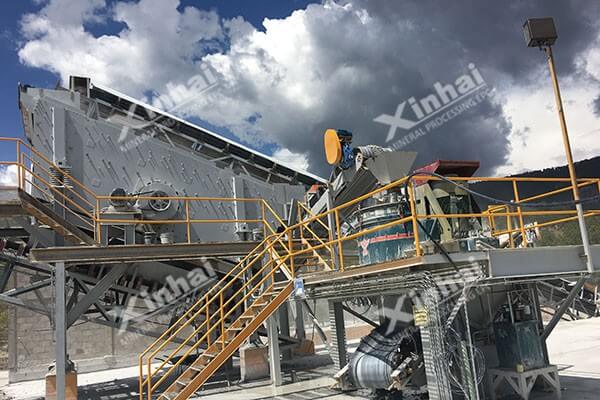
Screening is a process to separate broken materials with different particle sizes into several particle grade through single or multiple layer of screen meshes with uniform scree holes. The particles larger than the mesh holes are left on the sieve surface, which is called oversized product, and the particles smaller than the sieve pores pass through the sieve hole, which is called undersized product. The actual screening process is: after a large number of different sizes and coarse and fine mixed materials enter the sieve surface, only a part of the particles are in contact with the sieve surface. Due to the vibration of the screen box, the material on the screen is loosened, so that the gap existing in the large particles is further enlarged, and the small particles are passed through the gap and transferred to the lower layer or the conveyor. Since the small particles have a small gap, the large particles cannot pass through, and the originally disordered particle group is separated. That is, the layering is achieved according to the particle size, and the arrangement rule of the small particles on the bottom and the coarse particles on the top is formed. The fine particles reaching the sieve surface are sieved through the sieve, and finally the coarse and fine particles are separated to complete the screening process.
However, adequate separation is not available. When screening, a portion of the undersized product is typically left on oversized product. When the fine particles are screened,although the particles are smaller than the mesh holes, the ease of their screening is different. Particles with similar material and mesh size are difficult to pass through, and it is more difficult to pass through the particle gap in the lower layer.
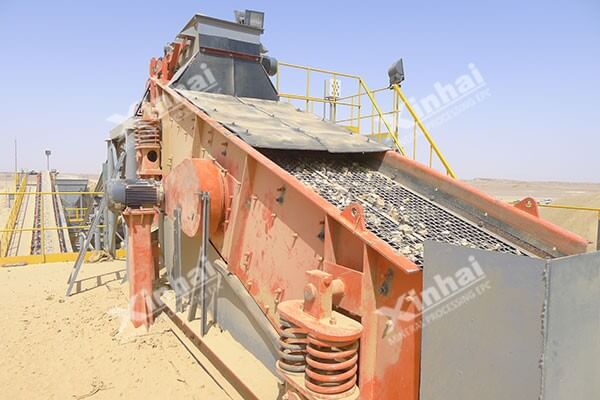
There are many classification methods for screening equipment, which can be classified according to the motion track and transmission mode, or classified according to their use. According to its structure, working principle and application, it can be roughly divided into:
Screening Equipment Types | Motion Track | Maximum Feed Size/mm | Application |
Static grizzly | Static | 1000 | Pre-screening |
Cylinder screen | The cylinder rotates in a certain direction. | 300 | Ore classification, desliming |
Roll screen | The screen roll rotates in a certain direction. | 20 | Pre-screening, bulk mineral screening, de-intermediation |
Shaker screen | Approximate straight line | 50 | Classification, dehydration, desliming |
Round vibrating screen | Circle, ellipse | 400 | Classification |
Linear vibrating screen | Straight line, Quasi line | 300 | Classification, dehydration, de-intermediation |
Resonant screen | Straight line | 300 | Classification, dehydration, de-intermediation |
Probability screen | Straight line, circle, ellipse | 100 | Ore classification |
Constant thickness screen | Straight line, circle | 300 | Ore classification |
High frequency vibration screen | Straight line, circle, ellipse | 2 | Fine material classification |
Electromagnetic vibrating screen | Straight line | Fine material classification |
Although there are many types of screening equipment,the most used one in the mineral processing plants is the vibrating screen. According to the motion track of the screen frame, the vibrating screen can be divided into two types: round motion vibrating screen and linear motion vibrating screen. The round motion vibrating screen includes single-axis inertial vibrating screen, auto centering vibrating screen, and heavy-duty vibrating screen. The linear motion vibrating screen includes linear vibrating screen(two-axis inertial vibrating screen) and resonance screen.
As a screening machine commonly used in concentrators,vibrating screens have the following outstanding advantages:
1. The sieve body vibrates violently with low amplitude and high vibration times, eliminating the blockage of materials and making the screening machine have higher screening efficiency and production capacity.
2. Low power consumption, simple structure,convenient operation and maintenance.
3. Because the vibrating screen has higher productivity, the required screen area is smaller than other sieves, which can save the workshop area and height.
4. Wide range of applications, suitable for pre-screening and check screening before secondary and fine crushing.
The working principle of circular vibrating screen is to make the exciter eccentric block generate high speed through the motor by the triangle. When the running eccentric block generates a large centrifugal force, the vibrating screen box produces a certain amplitude action. The continuous throwing action of the material on the inclined screen surface caused by the impact force transmitted by the screen box, when the material meets the circular vibrating screen surface, the particles smaller than the sieve hole will be sieved to realize the screening operation.
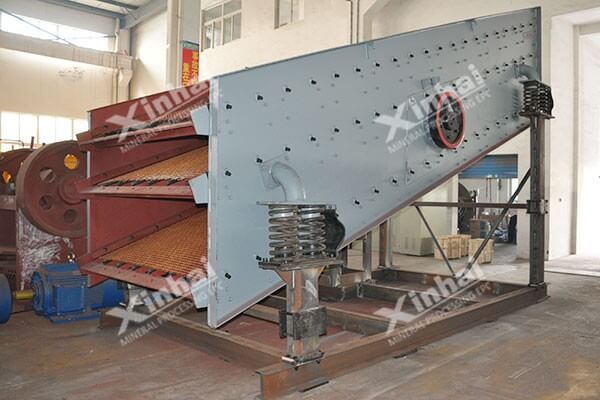
The circular vibrating screen adopts cylindrical eccentric shaft exciter and eccentric block to adjust the amplitude, the material sieve line is long and has many screening specifications. It has the characteristics of reliable structure, strong excitation force, high screening efficiency, small vibration noise, sturdy and durable, convenient maintenance and safe to use, the vibrating screen is widely used in product classification of mining, building materials, traffic, energy, chemical and other industries.
The working principle of auto centering vibrating screen is to use the motor to drive the main bearing of pulley. The generated centrifugal inertial force is added to the internal force of vibrating system of screen box, and the center of gravity of screen box system is driven to make a circular motion. The mass eccentric weight on partial wheel should ensure that the centrifugal inertial force generated by them can balance the centrifugal inertial force generated when screen box rotates, so that the condition that the center of pulley does not shift in space is the centrifugal inertia generated by the rotation of the screen box. The centrifugal inertia generated by eccentric weight is equal in magnitude and opposite in direction. At this time, the power balance is achieved, thereby realizing the “auto-centering”of pulley, so that the center distance of two pulleys remains unchanged, and the looseness of belt is eliminated.
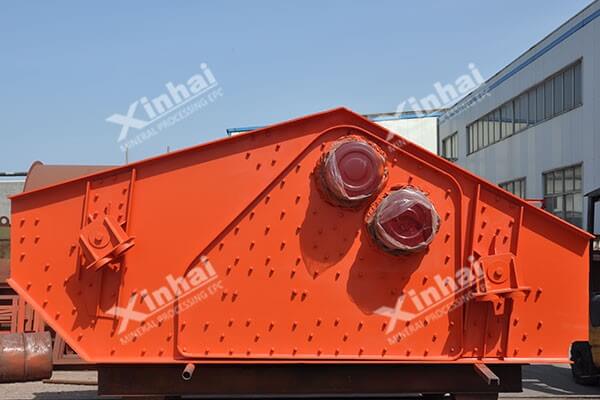
The advantage of auto-centering vibrating screen is that the stability of motor has been greatly improved, so the amplitude of screen can be slightly larger than that of inertial vibrating screen. The screening efficiency is higher, generally can reach more than 80%.However, in the process of operation, the amplitude of auto-centering vibrating screen is as noticeable as that of inertial vibrating screen. When the screen working load is too large, the amplitude is too small to shake up all the materials on the screen, so the screening efficiency is significantly reduced. When the screen working load is small, the amplitude increases sharply, the material shakes sharply, and it quickly jumps off the screen surface. The screening time is short and the screening efficiency will be reduced. So when using such a sieve, the amount of fed ore should not fluctuate too much. Therefore, the auto-centering vibrating screen is suitable for the screening of medium and fine grain materials under uniform ore feeding conditions.
Linear vibrating screen is driven by double vibration motors, while two vibration motors doing synchronous rotation and counter rotation, the vibration force generated by eccentric block is cancelled out with transverse vibration force, and the longitudinal vibration resultant force is passed on the whole screen surface, in this way, the motion track of screening equipment is a straight line. There is an inclination between the vibration force direction and screen surface, under the action of resultant force of vibration force and material gravity, the materials on screen surface are thrown up and jumped forward in a straight line. In this way, the materials screening and classifying are achieved.
Linear vibrating screen structure is mainly composed of screen box, screen frame, screen mesh, vibration motor, shock absorbing spring and bracket. The screen box is the main frame of vibrating screen, which is made of a variety of different steel plates welding and has certain rigidity and strength. The screen mesh is made of rubber screen, which has high screening efficiency. In addition, different screen materials can be selected according to user requirements.
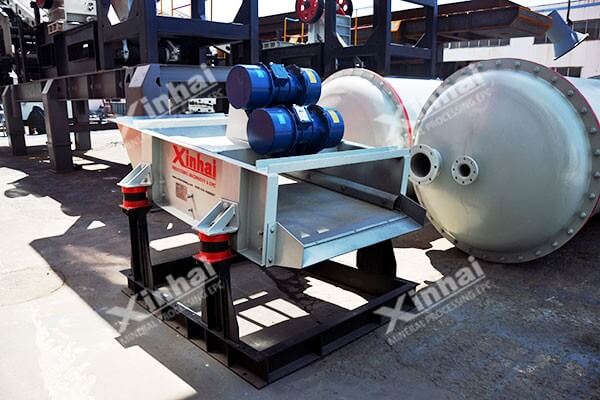
The linear vibration excitation force is large, the amplitude is large, the vibration is intense,the screening efficiency is high, the productivity is large, and coarse material can be screened. Due to the horizontal installation of screen, the efficiency of dewatering, de-sludge and de-medium is quite high. However, the shaker is complicated, and two shafts rotate at a high speed, so the manufacturing precision and lubrication requirements are high.
In the actual mineral dressing plants, many mine owners have encountered the problem that the vibrating screen fails to reach the predetermined processing capacity and the screening efficiency is low. As an important screening equipment, the screening efficiency of the vibrating screen will directly affect the quality and investment cost of the final product. When it comes to the screening efficiency of vibrating screens,its level is related to many factors, such as material properties, equipment structure and various performance parameters.
Without regard to the hard factors of material properties and equipment structure, we mainly analyze the influence of various parameter indexes on the screening efficiency of vibrating screen,including amplitude, vibration frequency, vibrating direction angle, angle of screen inclination and angle of projection. This content will be considered as a reference for the vibrating screen operation.
1. Amplitude of the Vibrating Screen
Generally, the larger the vibrating screen model, the greater the vibrating screen amplitude chosen. Because the amplitude of the vibrating screen is larger, the screen plugging phenomenon will be less,which is more conducive to the screening and stratification of the ore, and obtaining better screening production capacity. However, it should be noted that if the amplitude of the vibrating screen is too large, strong vibration will cause greater damage to the vibrating screen itself. In general, the amplitude of the vibrating screen is chosen by the ore size and nature. When the minerals are of small particle sizes, moist and also have a certain viscosity, we need to use low frequency and large amplitude screening equipment.In Addition, the screening equipment’s amplitudes and frequencies vary indifferent screening stage. For example, low frequency and large amplitude are normally used in screening operation before mineral beneficiation; while high frequency and small amplitude will be applied in dewatering and de-media operation.
2. Vibration Frequency of the Vibrating Screen
The vibration frequency has a direct effect on the bounce state of the ore particles on the screen surface. Taking the high-frequency vibrating screen as an example, its high frequency well destroys the tension of the slurry surface, causing the fine-grained material to oscillate at a high speed on the screen surface, accelerating the separation of useful minerals, and increasing the contact of particles smaller than screening size and the screening hole, thus creating a good screening condition.Excessive or too low vibration frequencies of the vibrating screen are not beneficial for screening efficiency. According to research, regardless of the screening operation of the vibrating screen, the better vibration frequency is maintained at 850-1000 beats / min. If the frequency is too low, the weight of the eccentric mass of the vibrator of the vibrating screen will increase with the same vibration intensity, which is not economical. Under the same vibration intensity of the vibrating screen, the higher frequency will greatly affect the running speed of the ore, which means reduced processing power. Therefore, the vibration frequency of the vibrating screen is not arbitrarily adjusted, and must be adjusted to the appropriate range according to the actual conditions of the plant, in order to make the vibrating screen perform optimally.
3. Sieve Angle of the Vibrating Screen
The inclined angle of the vibrating screen refers to the angle between the screen surface and the horizontal plane, and the angle of the vibrating screen is closely related to the processing capacity of the vibrating screen and the screening efficiency of the vibrating screen. When the inclination angle of the screen surface is increased, the movement speed of the ore particles on the screen surface becomes faster, and the treatment capacity increases accordingly, but at the same time, the residence time of the ore particles on the screen surface is correspondingly shorter, thereby affecting screening efficiency of the vibrating screen and vice versa.
Generally, an ideal screening efficiency of the vibrating screen can be achieved with a tilt angle range between 5° to 25°. Of course, there will be some differences between different models and screening operations. When the ore particles are above 50 mm, the screen inclination angle of the linear vibrating screen is usually maintained at 5° to 10°; and when the ore particles are below 40 mm, the screen tilt angle is 0°.
4. Vibration Direction Angle of the Vibrating Screen
The vibration direction angle mentioned here refers to the angle between the direction of the screening motion and the screen surface, and is generally expressed by β. When determining the direction of vibration direction of the vibrating screen, the primary consideration is the nature of the sieved ore. For ore with high density or finer size and easy to pulverize, the vibration direction angle of the vibrating screen should be large; and for those ore with large water content,strong viscosity or wear resistance, the vibration direction angle of the vibrating screen should be small. In actual production, most linear vibrating screen use 30°, 45° and 60° vibration direction angles. This direction angle of the vibrating screen not only can better adapt to various screening performance, but also obtain the best moving speed and screening efficiency; and the vibrating direction of the circular vibrating screen is 90°.Therefore, the circular vibrating screen needs to be installed obliquely,otherwise the mineral will not move forward.
5. Shaft Angle of the Vibrating Screen
According to the screening theory and practice, the size and strength of the vibrating screen throwing angle have a direct impact on the screening work. When the ore's projectile strength increases, the inertial force is also increased, and the ore is thrown higher,which is more conducive to the ore permeability. However, if the projectile strength is too large, it will inevitably affect the screen box and cause it to be damaged prematurely. Therefore, when selecting the proper projection angle size and strength in actual beneficiation plant, the factor of vibrating screen box should be taken into consideration.
In actual use, there will be some differences between different types of vibrating screens, which is unavoidable. It is recommended that all mine owners consult professional vibrating screen manufacturers before operation to adjust the vibrating screens according to the actual concentrators’ conditions, in order to achieve the desired performance of the vibrating screen and obtain the best screening efficiency.
Vibrating screen is a common screening equipment in industrial production. Due to various factors during the working process, the vibrating screen may be subject to various damages and failures.How to solve these problems is an issue that vibrating screens’ operators need to understand. This content introduces some common problems and related solutions of vibrating screens. We will explain each problem in detail below.
1. Material above the Vibrating Screen Flows Abnormally
There are two possible factors in this situation. One is that the anti-deformation ability of the vibrating screen box is not enough, that is, the rigidity of the screen box is insufficient, and the connecting bolt may be loosened, or it may be severe to fully loosened, tightening the connecting bolt can solve this problem. The other factor is the problem happens to the horizontal level of the screen box. This problem can be solved from the support base of the support spring or the support spring itself and by replacing the spring or adjusting the size of the support base. If there is no problem with the support base, it may be a horizontal level problem caused by the damage of the screen mesh, and replacing the screen mesh would solve the problem.
If the above problems cannot be solved in time, the beams of the vibrating screen maybe going to break if the condition is serious. In addition, improper operation or uneven feeding is also the cause of abnormal material flow.
2. The Vibrating Screen Fails to Start Up or the Amplitude is Too Small
In the case of such a problem, first we should check whether the electrical fault has occurred, whether the vibration motor has been damaged, or whether there is component damage or insufficient voltage in the line. If there is no problem in the above aspects, we can start from the machine and check if there is too much material accumulation on the vibrating screen. If the accumulated material is too much, we should remove them. If there is no problem in the above part, we should check whether the coupling bolt on the vibration exciter is off, whether the lubricating grease is agglomerated or thickened, we can service and clean the vibration exciter, and then make appropriate adjustment to the position of the eccentric shaft weighting block or the sub eccentric block.
3. Vibrating Screen Bearing Overheats
Under the condition of 4 hours of trail run, the temperature of the vibrating screen bearing should be maintained at 35~60 degrees. During the test run, if the temperature is high, there may be three main possible reasons. First, the radial clearance of the bearing is too small,thus the bearing load is increased and the frequency is arise, we should make the bearing have a large clearance and grind some part of the outer ring of the bearing. It is also possible that the bearing gland is over-tightened so that the bearing cannot properly dissipate heat, we should adjust the gasket between the end cap and the bearing housing. It may also be due to the lack of lubricating oil in the bearing or oil contamination, excessive oiling, etc. We should oil and clean the bearing and replace the oil and seal. In addition, it may be a problem of bearing wear or bearing quality.
4. Side Plate Cracks, Structural Parts Damage,or Even Beam Breakage of Vibrating Screen
This kind of situation does not happen suddenly. It is usually caused by too long working time at the critical frequency. There are many kinds of critical frequency conditions, such as:high-strength bolts of the side plates loosened, severe spring deformation which causes height difference, eccentric block weight error is too large, etc. The problems above will cause structural parts damage, side plate cracks or even beam breakage. While replacing damaged parts, the above conditions should be overhauled. When repairing the side plates, we should drill holes at both ends of the crack to prevent crack propagation. When repairing the reinforcing plate,we should drill the air holes on the reinforcing plate.
5. The Rotation of Vibrating Screen Turns Slow While the Bearing Heats Up
Most of this happens because there is no maintenance at ordinary times, resulting in the lack of lubricating grease in the bearing. If the grease is newly added, the problem may be caused by the grease quality problem or the addition of too much grease. Inferior grease will cause the bearing to block the sealing jam, so the quality of the grease needs to be guaranteed.
6. The Vibrating Screen Produces Excessive Noise
If the vibrating screen emits excessive noise during work, the parts of the equipment may be damaged or loose. We should stop the bearings, bolts, beams, springs, etc., and replace or fix the faulty parts in time.
7. The Screening Effect of Vibrating Screen is Not Good
There are many reasons for the poor screening effect of the vibrating screen. We can analyze the causes one by one.
First of all, different types of vibrating screens have different reasons for the poor screening effect. One of the main reasons for the poor screening effect of the circular vibrating screen is that the screen surface angle is insufficient. If the screen surface angle is insufficient, the rear support seat should be raised and the screen surface angle should not be lower than 16°. Otherwise, the material on the screen may not move smoothly or the material may roll upward. For linear vibrating screens and high-frequency vibrating screens, the poor screening effect is mostly related to the direction of movement of the eccentric block and we should adjust it.
In addition, the poor screening efficiency may be caused by the fact that the width of the feed chute is not appropriate,and the actual processing capacity is not consistent with that at the time of design. The vibrating screen needs to be modified according to requirements to improve the screening efficiency.
The above are some questions and solutions about the screening efficiency of vibrating screen. In actual production, the vibrating screen should be regularly maintained and repaired. When there is a problem, the cause should be identified according to the phenomenon, and the problem should be solved timely to ensure the safe and stable operation of the plant.
Users who are familiar with the working principle of vibrating screens know that whether it is circular vibrating screen, linear vibrating screen, auto centering vibrating screen or heavy vibrating screen, they all belong to the mesh screening equipment; that is,relying on the mesh size of vibrating screen to limit the screening of the target material to achieve the classification of the particle size or the screening of impurities, which belongs to the physical screening method. Therefore, the choice of suitable vibrating screen mesh is particularly important. It can be said that the screen mesh is one of the most vulnerable parts of the vibrating screen. So how to choose proper screen mesh for vibrating equipment? As a professional vibrating screen manufacturer, Xinhai Mining Company recommends:
1. Selection Criteria for the Quality of Vibrating Screen Mesh
The quality of the vibrating screen mesh not only determines its durability, but also determines the accuracy of the entire screening process. For the production standards of industrial woven wire cloth, the standard of Technical Requirements and Inspection of GBT 17492-1998 Industrial Woven Wire Cloth is currently followed, which specifies the technology and quality standards of stainless steel vibrating screen. In actual production, Xinhai Mining Company recommends five simple and easy methods to select the best quality woven wire cloth.
(1)Be sure to choose a formal vibrating screen manufacturer. Formal manufacturers are guaranteed both on the 304 stainless steel material and on the screen mesh quality. However,informal manufacturers may use inferior materials for higher profit.
(2)Under the same mesh number of screen mesh, you should choose the screen mesh with coarser wire diameter. Because the screen mesh of vibrating screen with coarser wire diameter is superior to the screen with finer wire diameter in the wear resistance and wear rate.
(3)Try to choose the vibrating screen mesh that has knotted on both sides, that is, edge sealing. The screen mesh that is over-sealed is not easily disengaged by the vibration of the vibrating screen.
(4)After getting the vibrating screen mesh, you can pull the screen mesh to ensure that it will not shake left or right, which means that the knitting strength of the vibrating screen mesh is the same, and the flatness, precision and damage resistance of the screen mesh are relatively high during the screening process.
In short, the quality of the vibrating screen mesh is a prerequisite for determining its durability. The good quality woven wire cloth is not only more durable and wearable, but also has great advantages in screening accuracy and screening rate. Therefore,we must be careful when choosing the vibrating screen mesh.
2. Selection Criteria for Mesh Number and Wire Diameter of Vibrating Screen Mesh
The core of the selection of vibrating screen mesh is to select the mesh number that meets the requirements of screening process, that is, to determine the mesh number and wire diameter of the woven wire cloth, which is related to whether the whole process of particle size classification or impurity filtration can meet the screening demand. In general, in order to ensure the durability of the large mesh vibrating screen mesh, we use a grid structure called "mother-son" on the circular vibrating screen, which consists of the mother mesh used for screening and the coarse wire diameter son mesh used for supporting the mother mesh. So what we need is to determine the mesh number and wire diameter of the mother mesh.
The mesh number and wire diameter of the vibrating screen mesh are primarily determined by the customer's screening requirements. For example, if the customer's screening requirements are for particle size classification. Then we need to determine the number of layers of the vibrating screen mesh and the exact mesh number required to screen each particle size based on the number of grades graded by the customer and the size range of each grade. If the customer's screening requirements are filtering or impurity removal, then the mesh number of the screen mesh does not need to be too precise. The wire diameter and aperture of the vibrating screen mesh can be selected mainly based on the screening equipment type and screening material